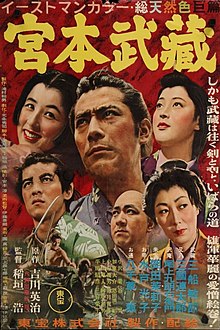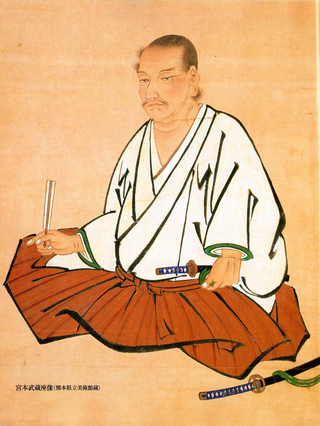
Miyamoto Musashi, born Shinmen Takezō, also known as Miyamoto Bennosuke and by his Buddhist name, Niten Dōraku, was a Japanese swordsman, strategist, artist, and writer who became renowned through stories of his unique double-bladed swordsmanship and undefeated record in his 62 duels. Musashi is considered a kensei of Japan. He was the founder of the Niten Ichi-ryū, or Nito Ichi-ryū, style of swordsmanship, and in his final years authored The Book of Five Rings and Dokkōdō.

Toshiro Mifune was a Japanese actor and producer. The recipient of numerous awards and accolades over a lengthy career, he is widely considered one of the greatest actors of all time. A leading figure in the Japanese film industry, he often played hypermasculine characters and was noted for his physical presence and commanding screen presence.

Vagabond is a Japanese epic martial arts manga series written and illustrated by Takehiko Inoue. It portrays a fictionalized account of the life of Japanese swordsman Musashi Miyamoto, based on Eiji Yoshikawa's novel Musashi. It has been serialized in Kodansha's seinen manga magazine Morning since September 1998, with its chapters collected in 37 tankōbon volumes by July 2014. Viz Media licensed the series for English release in North America and has published the 37 volumes by April 2015. The series has been on indefinite hiatus since May 2015.

Takuan Sōhō was a Japanese Buddhist prelate during the Sengoku and early Edo Periods of Japanese history. He was a major figure in the Rinzai school of Zen Buddhism. Noted for his calligraphy, poetry, tea ceremony, he is also popularly credited with the invention of the takuan pickled radish.

Hiroshi Inagaki was a Japanese filmmaker who worked on over 100 films in a career spanning over five decades. He is one of the most successful and critically acclaimed filmmakers in the history of Japanese cinema, having directed several jidaigeki epics such as the 1954 Academy Award-winning film Samurai I: Musashi Miyamoto, and its two sequels.
The Samurai Trilogy is a film trilogy directed by Hiroshi Inagaki and starring Toshiro Mifune as Musashi Miyamoto and Kōji Tsuruta as Kojirō Sasaki. The films are based on Musashi, a novel by Eiji Yoshikawa about the famous duelist and author of The Book of Five Rings.
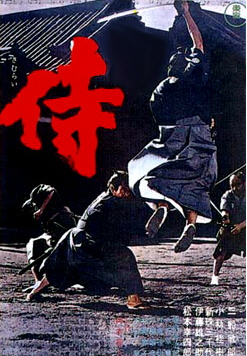
Samurai Assassin is a 1965 Japanese film directed by Kihachi Okamoto and starring Toshiro Mifune, Koshiro Matsumoto, Yūnosuke Itō, and Michiyo Aratama. It is set in 1860, immediately before the Meiji Restoration changed Japanese society forever by doing away with the castes in society and reducing the position of the samurai class.
This is a list of fictional depictions of Miyamoto Musashi, a 17th-century Japanese swordsman.

Duel at Ichijoji Temple is a 1955 Japanese film directed by Hiroshi Inagaki starring Toshiro Mifune. Shot in Eastmancolor, it is the second film of Inagaki's Samurai Trilogy.

Samurai III: Duel at Ganryu Island is a 1956 Japanese film directed by Hiroshi Inagaki and starring Toshirō Mifune. Shot in Eastmancolor, it is the third and final film of Inagaki's Samurai Trilogy.

Musashi, also listed as Musashi: An Epic Novel of the Samurai Era, is a Japanese epic novel written by Eiji Yoshikawa, about the life and deeds of legendary Japanese swordsman Miyamoto Musashi.
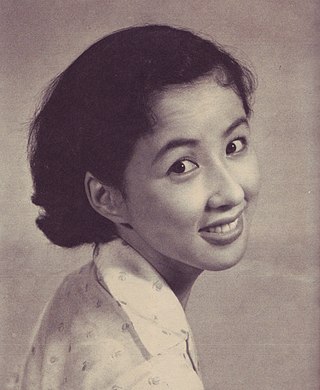
Kaoru Yachigusa was a Japanese actress from Osaka Prefecture. From 1947 to 1957, she was a member of the Takarazuka Revue. After leaving the revue, she was active in film, television, and narration.

Yorozuya Kinnosuke (萬屋錦之介) was a Japanese kabuki actor. Born Kin'ichi Ogawa, son of kabuki actor Nakamura Tokizō III, he entered kabuki and became the first in the kabuki tradition to take the name Nakamura Kinnosuke. He took on his guild name (yagō) Yorozuya as his surname in 1971.

Samurai Banners is a Japanese samurai drama film released in 1969. It was directed by Hiroshi Inagaki and is based on the novel Furin kazan by Yasushi Inoue.
Yūko Kotegawa is a Japanese actress from the city of Ōita.
Life of an Expert Swordsman is a 1959 samurai film directed by Hiroshi Inagaki and starring Toshiro Mifune. Its story is an adaptation of the 1897 Edmond Rostand play Cyrano de Bergerac, and its basic plot faithfully follows that of the play. The film was released in the English-speaking world with the title Samurai Saga.

Machibuse is a 1970 Japanese drama film directed by Hiroshi Inagaki.
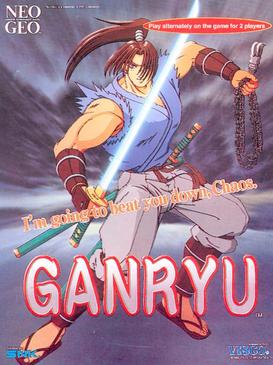
Ganryu is a 1999 side-scrolling hack and slash action-platform arcade video game developed and originally published by Visco Corporation exclusively for the Neo Geo MVS. It is loosely based upon the battle of Japanese swordsman Miyamoto Musashi on Ganryū-jima island against Sasaki Kojirō, who is also known as Sasaki Ganryū, hence the reasons for the abbreviated name of the game. In the game, players assume the role of either Musashi or Suzume on a journey to defeat a resurrected Kojirō and his legion of evil ninjas and monsters terrorizing Kyoto. A sequel, titled Ganryu 2: Hakuma Kojiro, was developed Storybird Studio and published by Just for Games and PixelHeart. It was released in April 2022 to generally mixed reception.

Musashi Miyamoto, born Shinmen Takezo, is the protagonist of Takehiko Inoue's manga series Vagabond. Seeking strength from a young age, Takezo involves himself in several battles, regardless of danger. After meeting the monk Takuan, Takezo is renamed Musashi Miyamoto and starts a new life to become invincible. Now, as an adult, Musashi faces new enemies and obtains fame through his wandering in Japan. While the manga never reached its ending, Inoue wrote pages in the form of an exhibition that depict the last days of an elder Musashi.
